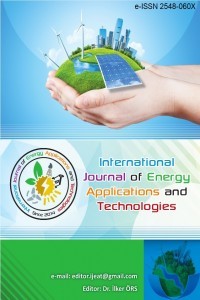Analysis of plate heat exchanger operating parameters by Taguchi Method
Analysis of plate heat exchanger operating parameters by Taguchi Method
In this study, the heat recovery performance of a plate heat exchanger, which provides air to air heat transfer was investigated. For the experimental set-up, a waste heat recovery device was designed and a heat exchanger was placed in it. Three different operating parameters were selected as fresh and exhaust air inlet temperatures and airflow rates. Three levels for each parameter were determined. The effects of changing parameters on the thermal effectiveness were analyzed by the Taguchi method. L9(33) orthogonal array was used in performing experiments. Results indicate that higher effectiveness can be obtained at low fresh air inlet temperature, low airflow rate, and high exhaust air inlet temperature. In this way, the optimum process parameter combination was revealed. Then, ANOVA was applied in order to detect the significance order of each parameter. The results show that the most important parameter among the others is the airflow rate. Moreover, the confirmation test was performed in order to obtain the optimum parameter combination. The experimental and predicted values are compatible with each other. This experimental study approves that the Taguchi method can be used in improving the exchanger performance.
Keywords:
Taguchi method, Plate heat exchanger, Cellulosic Air to air heat recovery, Thermal effectiveness,
___
- A. Mardiana and S. B. Riffat, “Review on physical and performance parameters of heat recovery systems for building applications”, Renewable and Sustainable Energy Reviews, vol. 28, pp. 174-190, 2013.
- M. S. Nasif, R. Al-Waked, M. Behnia, M. and G. Morrison, “Modeling of air to air enthalpy heat exchanger,” Heat Transfer Engineering, vol. 33, pp. 1010-1023, 2012.
- C. Kocabaş and A.F. Savaş, “Comparison of waste heat recovery performances of plate-fin heat exchangers produced from different materials, ” Contemporary Engineering Sciences, vol. 8(11), pp. 453 -466, 2015.
- Y. Lee, M. Jeng C. Huang, J. Perng, and C. Lan, “Analysis of cross-flow type of air-to-air total heat exchangers made of functional paper”, International Journal of HVAC & Research, vol. 11 (2005), 395-410.
- L. Zhang, Heat and mass transfer in plate-fin enthalpy exchangers with different plate and fin materials. International Journal of Heat and Mass Transfer, 52 (2009), 2704-2713.
- S. Liu, S. Riffat , X. Zhao , Y. Yuan, “ Impact of adsorbent finishing and absorbent filming on energy Exchange efficiency of an air-to-air cellulose fibre heat & mass exchanger”, Building and Environment, vol. 44, pp. 1803–1809, 2009.
- Junqi D., Yi Z., Gengtian L., Weiwu X., “Experimental study of wavy fın aluminum plate fın heat exchanger”, Experimental Heat Transfer, 26, 384–396 (2013).
- Zhao-gang Qi, Jiang-ping Chen, Zhi-jiu Chen, “Parametric study on the performance of a heat exchanger with corrugated louvered fins”, Applied Thermal Engineering, 27: 539–544 (2007).
- Turgut E.,Çakmak G., Yıldız C., “Optimization of the concentric heat exchanger with injector turbulators by Taguchi method”, Energy Conversion and Management, 53, 268–275 (2012).
- Bayram Şahin and Alparslan Demir, “Thermal performance analysis and optimum design parameters of heat exchanger having perforated pin fins”, Applied Energy Conversion and Management,, 49: 1684-1695 (2008).
- Tingting Du, Wenjing Du, Kai Che, Lin Cheng, “Parametric optimization of overlapped helical baffled heat exchangers by Taguchi method”, Applied Thermal Engineering, 85, 334-339 (2015).
- Isak Kotcioglu, Ahmet Cansiz and Mansour Nasiri Khalaji, “Experimental investigation for optimization of design parameters in a rectangular duct with plate-fins heat exchanger by Taguchi method”, Applied Thermal Engineering, 50, 604-613 (2013).
- C. Kocabaş and A.F. Savaş,. “ Analysis of Heat Exchanger Performance by Experimental Design Method”, Afyon Kocatepe University Journal of Science and Engineering, 18, 1174-1180, 2018.
- Özçelik B. Ve Özbay A., “Determinatıon of Effect on the Mechanical Properties of Polypropylene Product of Moldıng Materıals Using Taguchi Method”, Journal of Engineering and Natural Sciences Sigma 29, 289-300, 2011.
- R. Al-Waked, M. Ş. Nasif , G. Morrison, M. Behnia, “CFD simulation of air to air enthalpy heat exchanger”, Energy Conversion and Management, 74, 377–385, 2013.
- J.L. Niu, L.Z. Zhang, “Membrane-based Enthalpy Exchanger: material considerations and clarification of moisture resistance”, Journal of Membrane Science, 189, 179–191, 2001.
- Koyuncu T., “Design and construction of cross flow plate and finned type heat exchangers for ventilation”, Ph. D. Thesis, Trakya University, Institute of Science and Technology, Tekirdağ, 80, 1998.
- C. Kocabaş, A. F. Savaş, “Heat recovery optimization”, International Conference on Engineering Technologies, October 26-28, 2018, Konya, Turkey.
- A. Mardiana-Idayua, Saffa B. Riffat, “An experimental study on the performance of enthalpy recovery system for building applications”, Energy and Buildings, 43, 2533–2538, 2011.
- V.Yu. Borodulin, M.I. Nizovtsev, “A criterial analysis of the effectiveness of air-to-air heat exchangers with periodic change of airflow direction”, Applied Thermal Engineering vol. 130, pp. 1246–1255, 2018.
- T. Du, W. Du, K. Che, Lin Cheng, “Parametric optimization of overlapped helical baffled heat exchangers by Taguchi method”, Applied Thermal Engineering, vol. 85, pp. 334-339, 2015.
- M. Savaşkan, Y. Taptık., M. Ürgen , “Performance optimization of drill bits using design of experiments” [In Turkish],, İtu Article, Engineering, vol. 3(6), pp. 117-128, 2004.
- P. Liu, M. J. Alonso, H. M. Mathisena, C. Simonson, “Performance of a quasi-counter-flow air-to-air membrane energy exchanger in cold climates”, Energy and Buildings, vol. 119, pp. 129–142 , 2016.
- Yaïci W., Ghorab M. Entchev E., “Numerical analysis of heat and energy recovery ventilators performance based on CFD for detailed design”, Applied Thermal Engineering, vol. 51, pp. 770-780, 2013.
- Yayın Aralığı: Yılda 2 Sayı
- Başlangıç: 2014
- Yayıncı: İlker ÖRS
